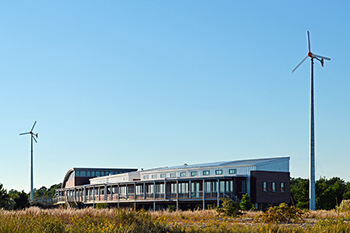 VIRGINIA BEACH, Va. — Construction completed last week on the Brock Environmental Center, a facility that promotes environmentally friendly efforts toward its neighbor, the Chesapeake Bay.
VIRGINIA BEACH, Va. — Construction completed last week on the Brock Environmental Center, a facility that promotes environmentally friendly efforts toward its neighbor, the Chesapeake Bay.
Detroit-based SmithGroup JJR designed the facility, and Virginia Beach-based Hourigan Construction, managed the construction. The 10,000-square-foot one-story building is serving as the hub for the Chesapeake Bay Foundation’s (CBF) Hampton Road office, and it was designed to support the foundation’s Chesapeake Bay education, outreach, advocacy and restoration initiatives.
While the environmental center is targeting LEED Platinum designation, it’s also reaching to meet strict building and design standards for the Living Building Challenge (LBC), a certification program developed by the International Living Future Institute that sets the most advanced measures of sustainability in the built environment. The Brock Environmental Center would become the first building in Virginia to earn full LBC certification and one of only a handful in the world.
For its new facility, the CBF wanted to transcend LEED and achieve a net zero impact on the environment. The facility, situated along the coastline, intends to produce zero waste from the 118-acre site and hopes to become a model for water conservation. Designers implemented sustainable ways to use very little energy by incorporating features such as natural ventilation, daylighting, sunshading, geothermal heating and cooling, and enhanced insulation.
The facility is also on track to become the first commercial-scale building in the U.S. to earn net-zero water status via a rainwater collection system that will store water in tanks under the building and then filter it for hand washing and drinking. The building will use a state-licensed water filtration system.
The facility also features waterless, composting toilets and all grey water, which is wastewater that’s generated from everyday use such showers and sinks. The grey water will be channeled through a wetland made of native plants where natural process will clean it and return it to an underground aquifer.
The environmental center aims to achieve net-zero energy status through generating its own electricity with solar- and wind-powered renewable energy. The facility has installed an array of 38.8-kilowatt rooftop solar panels that will support 60 percent of the building’s energy needs. Two, 10-kilowatt wind turbines will contribute to the remaining 40 percent of energy needs.
“With the Brock Environmental Center, CBF is raising the bar for sustainability,” said Greg Mellsa, FAIA, LEED AP, SmithGroup’s manager for the project and design architect, in a statement.
In addition to offices for CBF and partner groups, the center provides meeting rooms, exhibit display areas and an 80-seat conference room.
During construction, builders chose materials that are bio-based instead of heavily processed, synthetic and chemical-based options. The International Living Future Institute has a “Red List” of materials that are considered harmful to humans and the environment, and builders adhered to that.
Reclaimed materials were used extensively throughout the project. They include cypress siding from reclaimed sinker logs, wood flooring made from old fence posts and barn siding, interior wood trim from salvaged high school bleachers, and mirrors and toilet accessories from a local hospital demolition. The rainwater cistern and reception desk millwork were constructed from salvaged pickle barrels, and cabinet hardware consists of used champagne corks.
“We had the opportunity to push the envelope on innovative and creative methods,” said Chris Brant, executive vice president of Hourigan Construction, in a statement. “There were so many certification levels that needed to be met that it was a job in itself to keep track of them all.”

